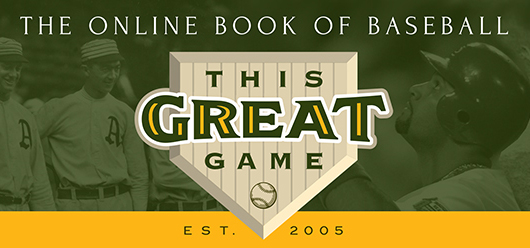Lists
The 10 Oddest Box Score Lines in Baseball History—Hitters Edition
A look at some of the strangest combinations of numbers ever collected by hitters in a baseball box score.
 For generations, baseball fans have looked at box scores and leaned on a core set of four numbers to quickly determine how a batter performed in a game. Those four are represented by at-bats, runs, hits, and runs batted in. Many media sources have expanded that palette over the years, adding columns for walks, strikeouts, home runs, men left on base, etc., all for the benefit of fantasy league participants and others seeking additional, quick-hit information in this age of intensified analytic attention. But the Gang of Four remains king.
For generations, baseball fans have looked at box scores and leaned on a core set of four numbers to quickly determine how a batter performed in a game. Those four are represented by at-bats, runs, hits, and runs batted in. Many media sources have expanded that palette over the years, adding columns for walks, strikeouts, home runs, men left on base, etc., all for the benefit of fantasy league participants and others seeking additional, quick-hit information in this age of intensified analytic attention. But the Gang of Four remains king.
On rare occasion, among the more typical box score lines like 4-0-1-0 or 5-1-2-2, you’ll see something that sticks out like a sore thumb, leading to reactions like, What? Huh? Is that a typo? How did the batter come up with those set of numbers? We looked it up and discovered the following 10 box score lines that astound, deceive, or just doesn’t make sense.
 11-0-0-0
11-0-0-0
Charlie Pick, Boston Braves vs. Brooklyn, May, 1, 1920
This long, dreary day for the well-traveled, below-average third baseman qualifies more as the saddest line in baseball history. Pick’s presence in the Braves’ lineup likely led to the game’s historic result, a 26-inning, 1-1 tie called on account of darkness—to say nothing of exhaustion. (Remarkably, both the Braves’ Joe Oeschger and Robins’ Leon Cadore pitched all 26 innings—but that’s another story.) Playing for his fourth team in what would be his final major league season at age 32, Pick made a pair of errors over the game’s first two innings—hardly surprising for a guy with a career .896 fielding percentage at third—though neither miscue resulted in a run for the opposing Robins. But Pick hurt the Braves more with what he did—or more aptly, didn’t do—at the plate. Over the first nine innings, Pick was hitless in five at-bats, marooning eight men on base; most painfully, with one out, the bases loaded, and the chance to win the game in the bottom of the ninth, he hit into a double play to extend the proceedings to, seemingly, infinity. In the 17 innings to follow, Pick appeared six more times at the plate—each time with nobody on base—and failed to reach. No major leaguer, before or since, has finished a hard 0-for-11 in a single major league game.
 6-0-0-3
6-0-0-3
Moose Solters, St. Louis Browns vs. Cleveland, August 11, 1935
Like Pick, Solters had his difficulty reaching base in another extra-inning game—but at least he found ways to bring home the baserunners. In a breakout season that would be his first of three straight knocking in at least 100 runs, Solters collected three RBIs while going hitless in six at-bats; no other player has brought home more mates in more ABs without a hit. Irony was not lost on fellow Browns players Lyn Lary and Tom Carey, who combined for seven hits—and no RBIs. But Lary would be the benefactor of the balls Solters put into play, scoring all three of the runs he knocked in—including the game-tying tally in the ninth. The game, the latter half of a doubleheader, made it through 11 innings before darkness prevailed and ended in a 7-7 tie.
 0-0-0-3
0-0-0-3
David Ortiz, Minnesota vs. Boston, July 3, 2000
The early-career showing by Big Papi against the team he would later star for was much like Solters’—minus the six at-bats. No player has knocked in more runs without officially registering an out. Ortiz “batted” home the first run with a two-out walk in the first, followed by sacrifice flies in the third and fourth innings. He was pinch-hit for in the sixth to avoid a lefty-on-lefty matchup, with the two guys who followed in his spot (Butch Huskey and Midge Cummings) each grounding out in their lone at-bat as the Twins eventually lost at home, 11-8. The Red Sox were so impressed with Ortiz’s overall numbers (3-for-4, seven RBIs) in the three-game series—not to mention a grand slam he belted against them in a make-up game later in the year—that they would eventually trade for him. The rest would be Hall-of-Fame history.
 4-4-0-0
4-4-0-0
Jimmy Barrett, Detroit vs. Cleveland, July 13, 1901
Having talked about guys who brought home baserunners without the benefit of a hit, we swing it over to the left side of the hit column with some interesting performances by players scoring a bunch of runs with no hits. On a typically wild and sloppy game indicative of the American League’s maiden season, Barrett’s Tigers and the opposing Cleveland Blues combined for 31 runs, 10 errors, and 27 hits—none of them struck by the 26-year-old center fielder. Yet nobody plated more runs on the day than his four. There’s no play-by-play account of the game, so beyond the two walks Barrett drew that’s in the classic box score, there’s no current way to ascertain how he reached base—but given the three errors committed by the Blues and the station-to-station mentality of the Deadball Era, chances are he got on via a defender’s miscue or fielder’s choice as the Tigers eventually clawed their way to a 19-12 win. (So it is noted: Tex McDonald had a similar line while playing for the Federal League’s Pittsburgh Rebels on May 7, 1914.)
 0-4-0-1
0-4-0-1
Sam Mertes, New York Giants vs. St. Louis Cardinals, August 12, 1903
One of the top hitters of his time, Mertes also racked up four runs without a hit—but also without an official at-bat. His career-high five walks—one of them drawn with the bases loaded—are what led him to continually reach base and score all those runs without having to worry about putting the ball in play as the Giants rolled to a 14-4 rout. The Cardinals apparently didn’t want anything to do with Mertes during the four-game series; after the five walks in the series opener, he managed a 1-1-0-0 line with three walks a day later, as the Giants prevailed once more, 9-7.
 1-5-0-0
1-5-0-0
Max Carey, Pittsburgh vs. Philadelphia Phillies, July 25, 1913
The Hall-of-Fame outfielder did one better than Mertes, scoring five times without a hit—and his performance in the Pirates’ 12-2 win serves as a reminder to never repeatedly walk an elite stolen base threat, because those walks will likely become doubles or triples. The opposing Phillies did not learn the lesson, giving four passes to Carey—who stole both second base and third twice. Additionally, Carey reached on an error against Phillies starter Tom Seaton, enduring his worst start in a season in which he’d rack up 27 wins. Carey would go on to steal 61 bases for the Bucs in 1913, his first of 10 years leading the league in that department.
 2-5-1-5
2-5-1-5
Roy Cullenbine, St. Louis Browns vs. Boston Red Sox, July 31, 1941.
If some of the above line scores weren’t bizarre enough, check out this collection of numbers from Cullenbine, in the midst of an All-Star campaign in which he’d set career highs for batting average (.317), RBIs (98), and walks (121). The outfielder’s lone hit came in the first inning when he belted a grand slam against the Red Sox at Fenway Park, accounting for most of his RBIs on the day. From that point on, he left it to the rest of his teammates to bring home the bacon in a game the Browns would win, 16-11. Cullenbine was hit by a pitch and later scored in the third inning; walked and scored in the seventh; walked and scored again, in the eighth; and walked and scored one last time in the ninth—this time with the bases loaded, bringing home his fifth ribbie. Statistical researcher Bill James once referred to Cullenbine as a “lazy bastard” for all the walks he drew, but if lethargy produced results like this, nobody would complain.
 6-0-5-0
6-0-5-0
Hank Aaron, Milwaukee Braves vs. San Francisco Giants, August 27, 1958
On the flip side of almost everyone we’ve discussed to this point, we have a box score line full of hits—but no RBIs or runs. The ‘0-5-0’ part of the line isn’t exceedingly rare; over 30 players have had such a game. But it seems odd that one of those guys is Aaron, the all-time leader in RBIs and fourth in runs scored. He’s also tops in extra-base hits, so it’s even odder to note that all five of Aaron hits on this otherwise statistically unproductive day were singles. (Final oddity: Of Aaron’s three career five-hit games, two of them consisted solely of singles.) All of Aaron’s hits against the Giants came in each of his first five at-bats; three of them came with a runner on base; and twice, he was left stranded at third base, keeping him 90 feet from wiping away one of those goose eggs in the box score. As the game moved into extra innings, Aaron got a chance for a sixth hit—perhaps something other than a single—but was retired on a comebacker to pitcher Al Worthington.
0-0-0-0
Barry Bonds, San Francisco vs. San Diego, September 12, 2002; San Francisco vs. Los Angeles Dodgers, September 25, 2004
On the face of it, there’s nothing weird about a 0-0-0-0 line, which is usually reserved for defensive replacements or relief pitchers who, before the DH became the full law of the land, thankfully never saw a turn at bat. But going a whole game and coming up totally empty in all four columns of your box score? As of this writing, there’s only been 19 recorded instances of a major leaguer appearing five times at the plate, with no at-bats, runs, hits, and RBIs. And only one guy has done it twice—and that’s Bonds, who “accomplished” both feats at an older age than any of the others on the short list. As everyone well knows, Bonds was hardly fading into obscurity at this time; his historic late-career surge—not-so-arguably fueled by PEDs—had made him a one-of-a-kind mega-threat. Thus, no pitcher wanted anything to do with him; of the 10 total walks Bonds was granted between these two games, four of them were “officially” intentional; the other six were likely cases of pitchers not giving Bonds anything good to hit, crossing their fingers (in vain) that he’d swing at a bad pitch or two. The strategy of total avoidance worked for the Padres in Bonds’ 0-for-0 against them—the Giants lost in 10 innings, 3-2—but it wasn’t enough for the Dodgers in the other game, as San Francisco rolled to a 9-5 victory.
 3-2-2-9
3-2-2-9
Jim Gentile, Baltimore vs. Minnesota, May 9, 1961
Talk about cleaning up! Barely a month into a monstrous career year in which he’d rack up 46 homers and 141 RBIs, Gentile started his uncommonly good day by launching a grand slam—then, an inning later, he did it again, becoming the first major leaguer to hit slams in consecutive innings—let along the first two innings. After Minnesota’s first two pitchers (Pedro Ramos and Paul Giel) had each served up one of Gentile’s slams, the next guy on the mound (Bill Pleis) didn’t want to be the third, winning one battle by not loading the bases for Gentile, and winning another by walking him rather than being taken deep. Gentile’s final two plate appearances came with a man on base each time, as he struck out and hit a shallow sacrifice fly that gave him his ninth RBI. No player in major league history has ever knocked in more runs on fewer hits; Gentile would power three more grand slams on the year, setting a major league record that would last 26 years.
Coming Soon: The 10 Oddest Box Score Lines in Baseball History—Pitchers Edition
 TGG Baseball Lists Index Our growing collection of baseball lists you always wanted to know but never had the time to go out of your way to find them.
TGG Baseball Lists Index Our growing collection of baseball lists you always wanted to know but never had the time to go out of your way to find them.






